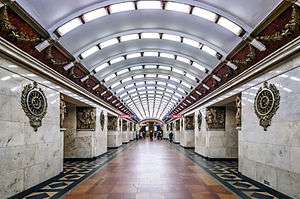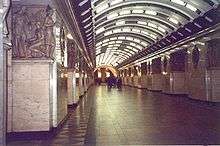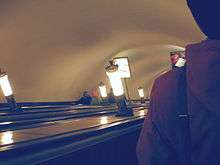Narvskaya
Narvskaya | |||||||||||
|---|---|---|---|---|---|---|---|---|---|---|---|
| Saint Petersburg Metro station | |||||||||||
 Station Hall | |||||||||||
| Coordinates | 59°54′04.35″N 30°16′29.65″E / 59.9012083°N 30.2749028°ECoordinates: 59°54′04.35″N 30°16′29.65″E / 59.9012083°N 30.2749028°E | ||||||||||
| Owned by | Saint Petersburg Metro | ||||||||||
| Line(s) |
| ||||||||||
| Platforms | Island platform | ||||||||||
| Tracks | 2 | ||||||||||
| Construction | |||||||||||
| Structure type | Underground | ||||||||||
| Depth | ≈52 m (171 ft) | ||||||||||
| History | |||||||||||
| Opened | November 15, 1955 | ||||||||||
| Services | |||||||||||
| |||||||||||
| | ||||||||||||||||||||||||||||||||||||||||||||||||||||||||||||||||||||||||||||||||||||||||||||||||||||||||||||||||||||||||||||||||||||||||||||||||||||||||||||||||||||||||||||||||||||||||||||||||||||
|---|---|---|---|---|---|---|---|---|---|---|---|---|---|---|---|---|---|---|---|---|---|---|---|---|---|---|---|---|---|---|---|---|---|---|---|---|---|---|---|---|---|---|---|---|---|---|---|---|---|---|---|---|---|---|---|---|---|---|---|---|---|---|---|---|---|---|---|---|---|---|---|---|---|---|---|---|---|---|---|---|---|---|---|---|---|---|---|---|---|---|---|---|---|---|---|---|---|---|---|---|---|---|---|---|---|---|---|---|---|---|---|---|---|---|---|---|---|---|---|---|---|---|---|---|---|---|---|---|---|---|---|---|---|---|---|---|---|---|---|---|---|---|---|---|---|---|---|---|---|---|---|---|---|---|---|---|---|---|---|---|---|---|---|---|---|---|---|---|---|---|---|---|---|---|---|---|---|---|---|---|---|---|---|---|---|---|---|---|---|---|---|---|---|---|---|---|
Legend | ||||||||||||||||||||||||||||||||||||||||||||||||||||||||||||||||||||||||||||||||||||||||||||||||||||||||||||||||||||||||||||||||||||||||||||||||||||||||||||||||||||||||||||||||||||||||||||||||||||
| ||||||||||||||||||||||||||||||||||||||||||||||||||||||||||||||||||||||||||||||||||||||||||||||||||||||||||||||||||||||||||||||||||||||||||||||||||||||||||||||||||||||||||||||||||||||||||||||||||||
Narvskaya (Russian: На́рвская) is a subway station in Saint Petersburg, Russia on the Kirovsko-Vyborgskaya Line between the stations Baltiyskaya and Kirovsky Zavod. The station opened on November 15, 1955, as part of the first stage of Saint Petersburg Metro from Avtovo to Ploschad Vosstania.
Overview
When the construction of the station first began, it was named Ploshchad Stachek (Translated "Square of the Strikes"), but several years before its opening, the name was changed to "Stalinskaya" after Joseph Stalin. Shortly before it opened in March 1953, Stalin died and the political structure changed. The station was renamed Narvskaya after the Narva Triumphal Gate, located opposite to the entrance to the station. This place-name indicates that it was once the gate of the road to Narva.[1] In spite of the name change, it still contains a large number of decorative elements relating to Stalin.
The irregular-shaped pavilion is built in the neoclassical style with a dome at one end. The station is lined in white marble with many bronze inserts. The walls of the vestibule are painted red and escalator balustrades are decorated with red plastic. There is a decorative strip of red stone on the upper portion of the walls in the underground hall, and the center of the station platform is constructed of red granite.
| Bus commercial routes | K-1, K-2, K-6, K-20, K-66, K-154, K-169, K-177, K-195, K-306, K-404 |
|---|---|
| Bus routes | 2, 6, 35, 35A, 66, 66A, 73, 111 |
| Trolleybus route | 20, 41, 48 |

Concourse
The station has one concourse, located on Strikes Square, at the corner of Staro-Peterhofskiy prospekt and Ivan Chernyh street. The vestibule of station was designed by architects I. V. Vasilyev, D. S. Goldgor, S. B. Speransky and engineer O. V. Ivanova.
The wall of the vestibule was planned to be decorated with an engraving of the text:
Russian: Не исключена возможность, что именно Россия явится страной пролагающей путь к социализму… Надо откинуть отжившее представление о том, что только Европа может указывать нам путь
Translated: It is not unreasonable to imagine that Russia will be the country to lead the way to socialism... One must discard the obsolete idea that only Europe can show us the way.[1]
Over the escalator run is a relief reading "Glory to Work!", sculpted by G. V. Kosov, A. G. Ovsyannikov, V. G. Stamov, and A. P. Timchenko. This area had been planned to contain an engraving of Stalin. (see the image)
In recent years, the station has struggled under the large volume of passenger traffic. Its three escalators have not been sufficient to carry passengers during the morning and afternoon rush hours. The escalators were built in the 1950s, and as such require occasional repairs. In peak hours, the station works only in one direction: as either an entrance or an exit.
In 2012, the station was closed for a 14-month reconstruction, which was planned to include the replacement of the three outdated escalators with four new ones.
Architectural appearance of underground hall

Three lines of escalators deliver passengers to the underground hall, which is at a depth of 52 meters. These escalators are illuminated by highly-artistic fixtures - cylinders topped with a metal crown which is bronze in color. Fixtures and the housing of the escalator motors, are made of steel and aluminium.
Below the escalators are small rooms closed off from the main areas. The main hall is illuminated graceful with fixtures located on the walls in groups of three.
The underground hall of pylon deep station was built under the direction of architects Alexander Vasilev, David Goldgor, Sergey Speransky and engineer O. V. Ivanova. The subjects of registration of the station reflect "labor valor of the Soviet people", and many elements are of Soviet era symbols: hammer and sickles, red stars, and images of red banners. On walls opposite the platforms are decorative lattices with the inscription «1955», the year of the station's opening. Illumination of the central hall is by fluorescent lamps located on consecutive arches of the ceiling, merging in the distance to create the impression of a continuous shiny surface.[2]
Originally there was a large mosaic panel "Stalin on a tribune" located on a prominent wall of the central underground hall. This mosaic was constructed by the director of the Academy of Arts of the Soviet Union, Aleksandr Gerasimov. Stalin's bust was to have been displayed on a colorful background; however, in 1961, after the XXII congress of CPSU, the panel was covered by a false-wall of marble, but a photo of the original panel had already been included in the book devoted to the line's opening.
In the fenced-off space, the boardroom which has occupied not only appendix, but also space to extreme steam of columns in underground hall took places. Later this premise was used as linear point of machinists of depot "Avtovo" which is still there. The wall with a mosaic has been disassembled, and staff only premises have been expanded to the following pair of columns. At the organization of a museum of underground of this mosaic there it has not been displayed, and its location and condition is not known.
On those corners of pilons which leave in the central underground hall the high reliefs representing people of different trades are established.

| Professions | Sculptor | In Russian |
|---|---|---|
| Peoples of art | Maria Litovchenko | Мария Тимофеевна Литовченко |
| Collective farmers | Mikhail Anikushin | Михаил Константинович Аникушин |
| Naval architects | Mikhail Gabe | Михаил Руфимович Габе |
| Scholars | Elena Chelpanova | Елена Георгиевна Челпанова |
| Plant selection breeders | Valentina Rybalko | Валентина Лаврентьевна Рыбалко |
| Tube builders | Alexander Ignatiev | Александр Михайлович Игнатьев |
| Textilemen | Lubov Hohlina | Любовь Михайловна Холина |
| Founders | P. Kulikov | П. А. Куликов |
| Seamen | V. Sichev | В. И. Сычёв |
| Doctors | N. Slobodinskiy | Н. К. Слободинский |
| Red soldiers | V. Pirozhkov | В. О. Пирожков |
| Builders | Alexander Chernitsky | Александр Николаевич Черницкий |
Facts and prospects
The 2.5 kilometre run between the Narvskaya and the Kirovsky Zavod stations is the longest on the initial stage of the Saint Petersburg Metro.[1] To meet the construction schedule for the opening, fast construction methods were employed. Information displays have been established with the purpose of informing of passengers on platforms of stations: under a phrase "the train follows to station" one of two variants was highlighted: Avtovo or Narvskaya.
The first stage of Saint Petersburg Metro was laid practically on an existing branch of a tram. To accustom passengers to use new transport, the tram line has been transferred on small streets, but at the metro station Narvskaya the tram ring has remained.[3]
After these tunnels ceased to be used for transport Line 1, they were used for storing Line 2 trains overnight. When in 1972 it has been constructed Depot 3 "Moskovskoye", all trains of Line 2 began to spend the night on the line.
Since the beginning of the 21st century, the station has been functioning continuously under a maximum load. In 2007, the Administration of the underground stated the intent to fully close the station for repair and replacement of escalators.[4] In July 2007 have been named the first terms is the end 2008 or the beginning 2009.[5] Terms of the beginning of works are constantly transferred, they are connected with station Gorkovskaya opening.
In 2008 the tender for manufacture and delivery of four escalators was won by factory Universalmash.
The information that the design-budget documentation on object takes place state expert appraisal has appeared in the summer of 2009. Plans have been specified is date has been specified second half-year 2010.[6]
References
- 1 2 3 Линия 1 [Line 1] (in Russian). Saint Petersburg internet newspaper. Retrieved 2009-08-23. External link in
|publisher=(help) - ↑ "The first stafe of Saint Petersburg metro". Narvskaya (in Russian). 2005. Archived from the original on 14 December 2007. Retrieved 2009-09-09.
- ↑ Транспортные чиновники забыли, что у "Нарвской" есть трамвайные пути [Transport officials have forgotten that at "Narvskaya" there are tram ring]. City (in Russian). fontanka.ru. 2009-08-30. Retrieved 2009-09-10. External link in
|publisher=(help) - ↑ Shahova, Victoria (2007-06-14). "Горьковскую", "Автово" и "Нарвскую" будут активно ремонтировать ["Gorkovskaya", "Avtovo" and "Narvskaya" will actively repair] (in Russian). dp.ru. Archived from the original on 25 May 2010. Retrieved 2009-09-09. External link in
|publisher=(help) - ↑ "the shorthand report of performance of the head of the Petersburg underground of Vladimir Garjugin on radio Echo of Moscow" (in Russian). Underground forum. 2007-07-18. External link in
|publisher=(help); - ↑ "Нарвскую" собираются закрыть через год ["Narvskaya" are going to close in a year] (in Russian). fontanka.ru. 2009-08-17. Retrieved 2009-09-09. External link in
|publisher=(help)
External links
-
 Media related to Narvskaya at Wikimedia Commons
Media related to Narvskaya at Wikimedia Commons - "Narvskaya" (in Russian). metro.vpeterburge.ru. Archived from the original on 30 August 2009. Retrieved 2009-09-09.
Closing of escalators of Saint Peterburg Metro on major repairs
| Preceded by Gostiny dvor (Aug 2008 - Aug 2009) Gorkovskaya (Oct 2008 - end of 2009 /planned/) |
Major repair with full closed end of 2009-2011/planned/ |
Succeeded by Grazhdansky Prospekt (2011-…/planned/) |
